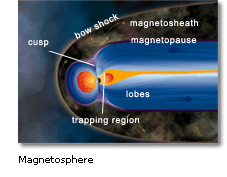

 |
|
|
|
 |
||
|
|
|
|
||||
 |
|
Magnetospheric Physics Description  Supports research on the magnetized plasma envelope of the outer atmosphere, including energization by the solar wind; the origin of geomagnetic storms and substorms; the population by solar and ionospheric sources; the origin of electric fields; the coupling among the magnetosphere, ionosphere, and atmosphere; and waves and instabilities in the natural plasma. Also supported are ground-based observational programs at high latitudes and laboratory experiments applicable to the geospace environment. Theoretical research programs may include numerical simulations using a variety of MHD, hybrid and particle codes. The analysis of data from all sources, whether ground-based or from spacecraft, is also supported. Supports research on the magnetized plasma envelope of the outer atmosphere, including energization by the solar wind; the origin of geomagnetic storms and substorms; the population by solar and ionospheric sources; the origin of electric fields; the coupling among the magnetosphere, ionosphere, and atmosphere; and waves and instabilities in the natural plasma. Also supported are ground-based observational programs at high latitudes and laboratory experiments applicable to the geospace environment. Theoretical research programs may include numerical simulations using a variety of MHD, hybrid and particle codes. The analysis of data from all sources, whether ground-based or from spacecraft, is also supported. GEM (Geospace Environment Modeling) program is an important program within the Magnetospheric Physics Program. More information about GEM's science programs can be found at the GEM Homepage maintained by UCLA. Another important initiative for the Magnetospheric Physics Program is the National Space Weather Program. There are also strong ties between the Magnetospheric Physics Program and the Aeronomy Program (including the CEDAR program), the Solar-Terrestrial Program (including SHINE) and Upper Atmosphere Facilities. Target Dates and Deadlines There are no deadlines or target dates for proposals sent in to any of the UARS base programs. However, we recommend that PIs try to send in proposals early in the fiscal year. Certain special programs within UARS do have deadlines for proposal submissions. See the table below for more information.
Program Contact(s) |
|
|